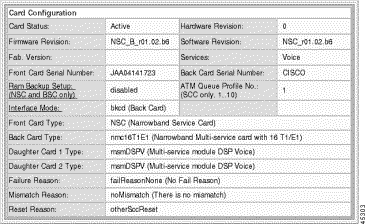|
|

The Cisco WebViewer has an intuitive interface that facilitates managing the Cisco MGX 8260 from a workstation with a standard Web browser.
Using the Cisco WebViewer, you can perform the following tasks:
You access the Cisco WebViewer using a standard Java-enabled Web browser, like Netscape or Microsoft Internet Explorer. Figure 1-1 shows the opening screen.

Every Cisco WebViewer screen has three panes:
1. System information
2. Navigation
3. Display and control
The Cisco WebViewer presents Cisco MGX 8260 status and configuration information in the following views:
The Chassis View shows the Cisco MGX 8260 front panel, including an accurate representation of the installed cards and their current LED states. The cards and LEDs are active areas on the screen, so you can get more information about an LED indication by clicking it. To view configuration information about a card, click elsewhere on the desired card.
In the Chassis View, the following LEDs are displayed and updated in real time:
Status screens display a summary of installed cards, configured services, or other information. Figure 1-2 shows an example of a screen that displays card configuration and status information.

Many status screens contain buttons that open other configuration screens. For example, the plus icon links to the form for adding a card.
You use configuration forms to define the parameters for a given card or service. Figure 1-3 shows an example of a form that contains card configuration information.

The configuration forms contain both informational and user-defined fields. In some cases, the fields contain hyperlinks to additional configuration forms. Because of security restrictions, not all users can access configuration forms.
You use a standard Web browser, such as Netscape Communicator or Microsoft's Internet Explorer, to communicate with the Cisco WebViewer interface of the Cisco MGX 8260. Microsoft Internet Explorer is preferred over Netscape Communicator because web page reloading is generally faster. If you don't already have a browser installed, download one from Netscape or Microsoft and install it on your machine.
Microsoft Internet Explorer has to be Version 4.0 or greater. For the Java-based Chassis View to display correctly, ensure that sufficient memory and disk space are available for gif, jar, and html files to be correctly loaded and executed.
To configure Microsoft Internet Explorer, follow these steps:
Step 1 From the Tools menu, select Internet Options.
Step 2 On the Temporary Internet Files pane, click Settings.
Step 3 Click Every visit to the page.
Step 4 Click OK.
Netscape Communicator has to be Version 4.5 or greater. For the Java-based Chassis View to be displayed correctly, ensure that sufficient memory and disk space is available for gif, jar, and html files to be correctly loaded and executed.
To configure Netscape Communicator, follow these steps:
Step 1 From the Edit menu, select Preferences.
Step 2 In the Category pane, click Advanced and Cache.
Step 3 Set the memory cache to 1024 K bytes.
Step 4 Set the disk cache to 50000 K bytes.
Step 5 Under "Document in cache is compared to document on network," select Every time. This option assures that the page you see is always the latest.
Step 6 Click OK.
To troubleshoot Netscape Communicator when the Chassis View does not display, follow these steps:
Step 1 From the Edit menu, select Preferences.
Step 2 In the Category pane, select Navigator.
Step 3 Click Clear History.
Step 4 Select Edit; then click Preferences
Step 5 In the Category pane, select Advanced and Cache.
Step 6 Click Clear Memory Cache.
Step 7 Click Clear Disk Cache.
Step 8 Click OK.
Step 9 Close Netscape and then restart it.
The management station communicates with the Cisco MGX 8260 over the management IP network. To use this network, you must initialize the IP address and gateway of the Cisco MGX 8260 management interface.
Assuming that you installed the Cisco MGX 8260 using the procedures in the Cisco MGX 8260 Hardware Installation Guide, the management interface is already configured. If your IP network includes a firewall, you must also open an http port to the Cisco MGX 8260.
At the logon prompt, enter a valid account name and password for the Cisco MGX 8260. Use the default account (SuperUser) and password (cisco) for new installations until you configure custom user profiles.
When the browser is first connected to the Cisco WebViewer, users are prompted to grant the execution privilege for specific Java applets. Users should grant the access and select always allow this access for subsequent operations.
Users can have up to ten browser sessions with a Cisco MGX 8260 from either the same or different workstations (IP addresses). However, only one browser session on an IP address can correctly receive the real-time chassis view updates. For those browsers that do not receive real-time updates, users must click Chassis View on the navigation pane to refresh the display.
If the web connection is terminated because of processor switchover, reset, or other reason, close the browser, restart the browser, and establish the connection by repeating the logon process.
![]()
![]()
![]()
![]()
![]()
![]()
![]()
![]()
Posted: Mon Nov 25 11:02:58 PST 2002
Copyright 1989-2000©Cisco Systems Inc.